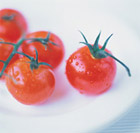| |
Fruits and Vegetables Inhibit Many Cancers
|
|

It has been over 10 years since a milestone report was published that suggested that a lowfat diet including plenty of fruits and vegetables may lower the risk of developing cancer, according to Karen Collins, M.S., R.D., of the American Institute for Cancer Research in Washington, D.C.
Initial research focused on the benefits of dietary fiber, vitamin A, vitamin С and other nutrients in fighting cancer, she said. More recent studies have revealed the surprising benefits from a variety of substances found in fruits and vegetables, many of which are not generally classified as nutrients. It seems that our diets may influence the early stages of cancer by impacting upon the levels of certain enzymes within our body cells.
"Last year, broccoli was making big headlines when researchers identified it as a source of sulforaphane, a chemical which seems to stimulate body production of enzymes that detoxify carcinogens and stop their damaging activity," Collins continued.
Broccoli is also a source of another group of substances, called indoles, which also serve to induce protective enzymes, she said.
"Other research suggests that indoles may influence estrogen metabolism in ways that could lower risk of breast cancer," Collins added. "Indoles are found in a class of vegetables called cruciferous vegetables, which include not only broccoli, but also all types of cabbage, cauliflower, brussels sprouts, bok choy (Chinese cabbage) and kale."
She went on to say that garlic and onions may offer help in lowering risk of certain cancers because of the sulfur compounds they contain. Cancers of the digestive tract, specifically esophagus, stomach and colon, as well as lung cancer seem to be influenced by the ability of these compounds to stimulate detoxification of carcinogens.
A higher consumption of fruits and vegetables is consistently associated with a reduced risk of cancer at most sites, reported Kristi A. Steinmetz and John D. Potter in Cancer Causes and Control in 1991. This is especially pertinent for cancer of the epithelial cells and of the alimentary and respiratory tracts, they said.
In addition, they continued, carotenoids (beta carotene, lycopene, etc.), vitamin C, vitamin E, selenium, dietary fiber, dithiolthiones, glucosinolates and indoles, isothiocyanates, flavonoids (rutin, quercetin, hesperidin, etc.), phenols, protease inhibitors, plant sterols, allium compounds (in garlic) and limonene all have potential anticarcinogenic activity.
These various compounds seem to have overlapping functions, such as inhibiting nitrosamine formation, for helping to form antineoplastic agents, the dilution and binding of carcinogens inside the gastrointestinal tract, in altering hormone metabolism and in providing antioxidant protection, the researchers said.
The authors reviewed studies showing the efficacy of the above substances in preventing cancer, and conclude that cancer formation may be due to the reduced intake of certain foods that are metabolically useful.
They added that fruits and vegetables contain an anticarcinogenic "cocktail" that we have adapted to over time, and when we abandon this rich source of nutrients we may suffer the consequences.
In the same publication, the author! review the epidemiology of fruit anc vegetable consumption in human cancer. Of the 13 ecological studies, nine cohort (group) studies and 115 casecontrol studies, the authors conclude that the consumption of large amounts of fruits and vegetables is generally associated with a reduced risk of cancer at most sites. Raw fruits and vegetables are thought to generate a consistently lower risk for developing certain cancers. As we reported in an earlier issue, Gladys Block, M.D., and colleagues stated in Nutrition and Cancer in 1992 that, in evaluating 200 studies concerning fruit and vegetable consumption and various cancers, there was a significant protective effect in j of the 156 dietary studies.
Health food stores now carry broccoli supplements that contain vitamin C, beta carotene, sulfur, glucosinolates, isothiocyanates, indole and other beneficial sut stances.
|
|
 |





